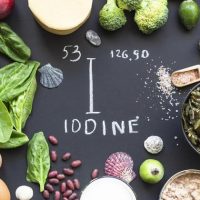Understanding the Crucial Role of Iodine in Health
Iodine plays a pivotal role in the overall health of individuals, right from boosting the body’s metabolic processes to ensuring the normal growth and development in children. One of its primary functions is the synthesis of thyroid hormones – thyroxine (T4) and triiodothyronine (T3). These crucial hormones regulate key biological functions such as heart rate, blood pressure, body temperature, and weight. Without the right levels of iodine intake, the body’s natural equilibrium can become disrupted, leading to conditions like hypothyroidism and goiters.
Apart from its critical role in supporting thyroid function, iodine is also involved in other biological processes. It aids in the removal of toxic chemicals from the body, protection against cancer, and the growth of healthy hair, skin, and nails. Moreover, a significant percentage of the body’s iodine is stored in the mammary glands where it plays a crucial part in fetal brain development during pregnancy. Regardless of its critical importance, the understanding and importance of iodine in nutrition are little known, and iodine deficiency remains a global health concern.
Exploring the Widespread Use of Iodine in Medicine
Iodine has long held a central position in various areas of medical treatment and prevention. An element in its natural state, it is commonly employed in its compounds’ form for its antiseptic properties. Its application extends from preoperative skin disinfection and wound care to addressing deficiencies in dietary intake. The World Health Organization recognizes iodine as a key micronutrient, critical for proper thyroid function and hormonal balance.
In medical imaging, iodine has been invaluable due to its high atomic number, making it an ideal contrast agent in radiography. This unique characteristic enables better visualization of structures and thus, precise identification of abnormalities in the body. Similarly, in dermatology, iodine is the resounding answer to various skin conditions ranging from minor cuts to fungal infections. This fundamental, yet versatile, element has a vast array of applications in the medical field, reflecting its profound importance.
Benefits of Iodine to the Human Body
As an essential nutrient, iodine plays a pivotal role in maintaining optimal health. It is fundamental for the function of the thyroid gland, which uses it to produce thyroid hormones. These hormones regulate many critical physiological functions, including metabolism, brain development, bone health, and immune response. Therefore, maintaining a sufficient intake of iodine is crucial to uphold a steady synthesis of these hormones and avoid related disorders such as hypothyroidism and goiter.
Furthermore, iodine exhibits significant antimicrobial properties, making it a popular component in many medical applications. It is used widely in sterilization and disinfection procedures due to its capacity to kill bacteria, viruses, fungi, and spores. It also promotes skin health and healing, potentially enhancing wound healing processes. Interestingly, research also points towards a correlation between adequate iodine intake and a reduced risk of certain types of cancers, further emphasizing its importance to human health.
Uncovering the Science Behind Iodine Use on Heels
Iodine, a halogen element known for its essential role in thyroid hormone synthesis, is also recognized for its significant contribution to skin health, particularly in wound healing. The application of iodine on the heels has been a common practice, especially in the treatment of cracks, fissures, and other skin issues. The elemental form of iodine demonstrates a broad-spectrum antimicrobial property that aids in disinfecting wounds and preventing infections, thus promoting the wound healing process.
Exploring this traditionally established use of iodine, contemporary medical science has unveiled the mechanisms behind its effectiveness. The integrated process involves iodine interacting with living cells and tissues, leading to the generation of iodine-induced oxidative species, a key player in the wound cleansing process. These reactive species contribute to the germicidal action of iodine by disrupting vital components of the microbial cells, helping eliminate pathogens at the site of the wound. Furthermore, iodine helps modulate the inflammatory response and stimulate growth factors and fibroblasts, vital for tissue regeneration and wound closure.
Impact of Iodine on Skin Health and Healing
Iodine has a strong foothold in the health industry due to its significant effect on skin health and the healing process. This element is a potent antimicrobial agent that aids in preventing infections and accelerates wound healing. Compared to other topical ointments, iodine has a broader range of effectiveness, combating bacteria, viruses, yeasts, fungi, and even some parasites. As a result, iodine-based treatments have been extensively utilized in healthcare settings for wound management to promote faster healing and reduce the risk of wound-related complications.
In relation to skin health, iodine performs a crucial role in maintaining skin hydration and elasticity, as it actively participates in the formation of collagen and elastin. These two structural proteins are vital for skin strength and flexibility. Additionally, iodine deficiencies are often marked by dry and rough skin, due to the decreased ability to produce healthy new skin cells. Thus, adequate intake of iodine, either through dietary sources or topical application, is essential for maintaining optimal skin health and advancing the body’s natural healing process.
Insights into the Healing Mechanism of Iodine
Iodine, a halogen element found abundantly in seawater and earth’s crust, has profound implications in the health sector due to its stunning healing properties. It has been established as an effective antiseptic since the 19th century because of its broad-spectrum activity against a wide range of pathogens. Largely, the topical application of iodine prompts the body to increase blood circulation in the area, thereby supplying significant nutrients and oxygen that enhance the body’s natural healing process.
The potent bactericidal action of iodine is linked to its ability to penetrate and destroy the protein and nucleic acids of microorganisms, making it an optimal choice for wound management. Interestingly, this disinfecting agent does not differentiate among bacteria, fungi, viruses, or protozoa, implying its indiscriminate action against pathogens. These unique characteristics make iodine a valuable component, not only in the personal care and cosmetic industry but also in the pharmaceutical arena where it finds applications in the preparation of several drugs and contrast media.
Addressing Common Myths and Misconceptions about Iodine Use
Despite iodine’s widespread use and recognized benefits, several misconceptions continue to circulate around its efficacy and safety. A common myth is that iodine is an inherently harmful substance or poison that can lead to adverse health conditions. In reality, while excessive iodine, like any other substance, can be toxic, small, well-regulated amounts have proven beneficial. Iodine is an essential mineral required for the proper functioning of the thyroid and the production of thyroid hormones, which regulate numerous bodily functions.
Another widespread belief centers on iodine allergies. Many individuals mistakenly believe that they are allergic to iodine, often confusing adverse reactions to radiological contrast dyes, seafood, or antiseptics with an allergy to the mineral iodine. It’s crucial to clarify that allergic reactions to iodine are incredibly rare. It’s typically not the iodine itself but the additives in iodine-based products or foods that cause reactions. Thus, the fear of iodine due to allergy concerns is, in many cases, based on misunderstanding rather than scientific fact.
Safety Measures for Applying Iodine on Skin
The effective and safe use of iodine on skin necessitates the understanding and adherence to certain precautions. First and foremost, iodine should be used in appropriate concentrations to avoid potential skin damage; overuse or use of highly concentrated iodine solutions can cause skin irritation, redness and in some cases, burns. It’s also important to note the suitability of iodine based on individual skin types. People with sensitive skin or those with known allergies to iodine should exercise caution and ideally, seek medical advice before applying iodine.
Notwithstanding its abundant health benefits, some significant risks can arise from improper iodine use. For instance, excessive application can lead to systemic absorption, particularly in individuals with impaired kidney function, leading to a medical condition known as iodine toxicity. Additionally, since iodine can stain skin and clothes a brownish hue, careful application is required to prevent unnecessary staining. However, despite these risks, when used properly and in moderation, iodine can be a powerful tool for skin health and healing.
Innovative Uses of Iodine in Everyday Life
Even beyond its well-known health benefits and medical uses, iodine presents itself as a versatile element employed in diverse applications in our daily lives. One of the most intriguing uses of iodine is in water purification. Access to clean water is a global challenge that affects millions of people worldwide, and iodine is often brought to service in treating and sterilizing water sources. A mere few drops of an iodine solution can transform unsafe water into a consumable commodity, demonstrating the pivotal role iodine plays in enhancing global water security.
Another noteworthy use of iodine is in photography. Since the era of black and white photos, iodine has proven itself indispensable in the development of photographic film. The technique of halogenation, which uses iodine, is an integral part of making the photosensitive compounds used in film. Today, this process continues to be vital in analogue photography and is a striking testament to iodine’s diverse uses. The applications of iodine extend far beyond these examples, however, confirming the element’s incredible range of relevancy in the average person’s life.
Future Perspectives and Research on Iodine Use
As we move into the future, the potential of iodine in medical and health science continues to create excitement among researchers worldwide. Advanced studies are underway to understand more about iodine’s impact on our health, and findings have been inspiring. The beneficial effects of iodine on immunity, cognitive function, skin health, and many other areas are receiving increased attention, giving rise to the hope for a broader spectrum of iodine-based treatments and preventative measures.
Meanwhile, research regarding iodine use in non-medical applications is unfolding as well. Scientists are exploring innovative ways to incorporate iodine in agriculture, food supplementation, and even environmental preservation. The use of iodine to boost plant health and productivity, replenish iodine deficiency in the food chain, and reduce environmental pollutants are promising notions. This broad level of inquiry signals the future holds endless possibilities for utilizing iodine in diverse and groundbreaking ways.






























